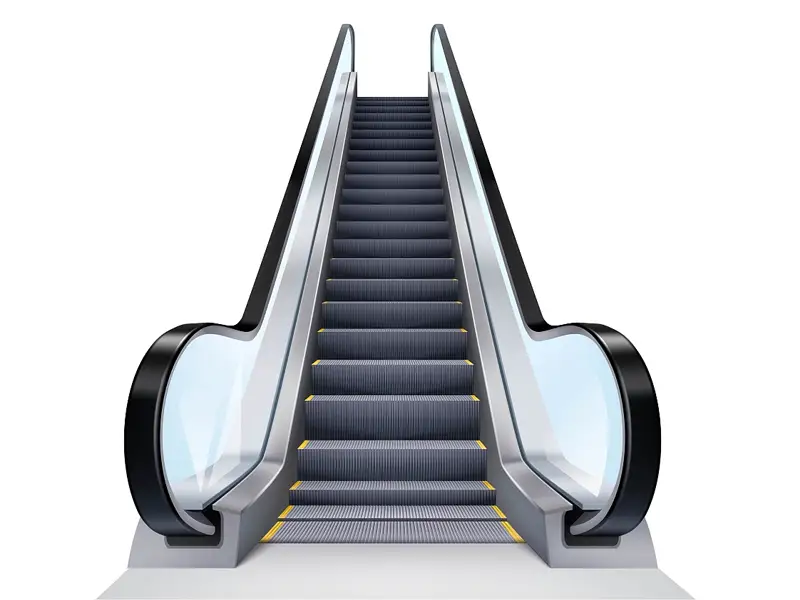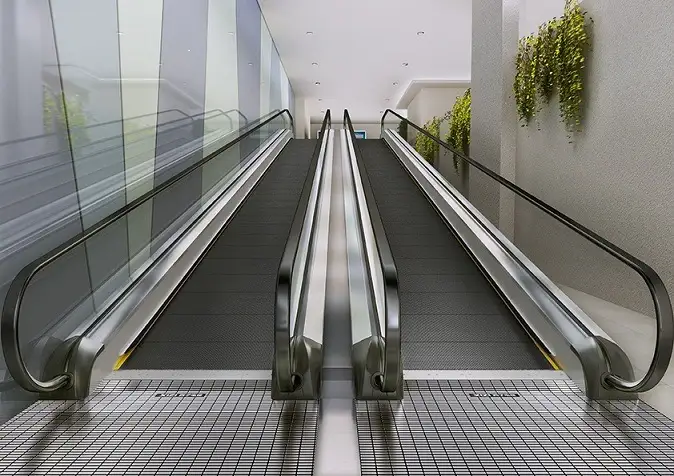Definition of Escalator & Moving Walkway
Escalator
An escalator is a type of vertical transportation that resembles a moving staircase that transports people between building floors. The steps are powered by a motor and move along a track. Escalators are commonly used to move large groups of people quickly and efficiently in shopping malls, airports, and train stations.

Get advice from Dazen experts on escalators! Click here!
Moving Walkway
A moving walkway also known as an autowalk, travellator, or travelator, is a horizontal conveyor belt that transports people. They are similar to escalators, but they transport people over long distances at a slower speed. Moving walkways are commonly found in airports, train stations, and large buildings to assist people in journeying long distances more efficiently.

Get advice from Dazen experts on Moving Walks! Click here!
Escalator vs Moving Walkway: 4 Big Differences
Escalators and moving walkways are conveyor systems used to move people horizontally or vertically. However, there are some critical differences between the two.
1. Traffic Flow and Speed
Moving walkways are horizontal and move people in a flat direction, whereas escalators move people vertically.
When compared to moving walkways, escalators typically move at a slower speed. Because escalators are designed to travel vertically, they must move at a slower speed for safety reasons. Moving walkways, in contrast, move quickly to help people cover longer horizontal distances faster.
2. Safety
Escalators have safety features such as handrails, skid-resistant steps, and safety sensors to keep users safe. Moving walkways, like stationary walkways, have safety features like handrails, but the steps are usually flat and non-slip.
3. Capacity
In general, escalators transport fewer people at a time than moving walkways. Because escalators are typically narrower and have less floor space, this is the case. Moving walkways are more extensive and, therefore, can accommodate more people simultaneously.
4. Tilt Degree
The inclination angle of escalators is generally 30° or 35° with stair-type steps. While the inclination angle of the escalator is not more than 12°, without stair-type steps, it can also be used for horizontal transportation.

Use of Space
Escalators can be used in various public places such as airports, railway stations, hospitals, office buildings, shopping centers and art galleries.
Moving walks can be used in airports, stations, docks, supermarkets, exhibition halls, gymnasiums and other crowded places
Similarities: Components of Escalator and Moving Walkway
Steps/treads
Steps or treads are the flat surfaces on which people stand and walk while using an escalator or moving walkway. They are typically made of durable materials such as metal or plastic. They are designed to be slip-resistant and easy to clean.
Handrails
Handrails are long bars that run alongside the steps or treads. They provide support and stability for users as they move up or down the escalator or moving walkway. They can be made of various rubber, plastic, or metal materials. They are designed to be comfortable to hold and easy to clean.
Drive System
The drive system is the mechanism that powers the movement of the steps or treads. It typically consists of a motor, gears, and a drive belt or chain. The motor generates the power to move the steps or treads, while the gears and drive belt or chain transmit the power to the steps or treads.
Safety Features
Safety features are an essential component of escalators and moving walkways. Some standard safety features include emergency stop buttons, safety sensors, and skid-proof surfaces:
Emergency stop buttons allow users or operators to quickly stop the escalator or moving walkway in an emergency.
Safety sensors detect obstacles or problems on the escalator or moving walkway and shut them down if necessary.
Skid-proof surfaces help to prevent slips and fall.
Conclusion
Dazen Elevator is a leading provider of escalators, moving walkways, and other transportation systems. We are committed to providing our customers with the best possible experience. If you are looking for a reliable and efficient transportation system for your space, contact us today to learn more about our products and services.
